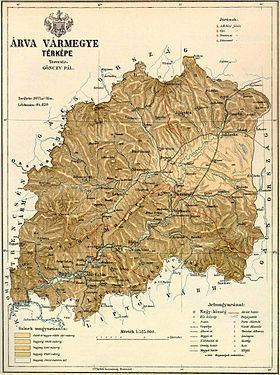Established 14th century 1910 2,019 km (780 sq mi) Area 2,019 km² | Abolished 1920 1910 78,700 | |
 | ||
Capital Alsókubin (Dolný Kubín) | ||
Árva County (Hungarian: Árva vármegye, Latin: Comitatus Arvensis, Slovak: Oravská stolica/župa, German: Komitat Arwa, Polish: Komitat Orawa) was an administrative county (comitatus) of the Kingdom of Hungary since the 14th century until 1918/1920. Its territory is now in northern Slovakia and southern Poland. Today, the Slovak name is only used as an informal designation of the corresponding territory (see Orava region).
Contents
Geography
Árva County shared borders with the Austrian land Galicia and the Hungarian counties Trencsén, Turóc and Liptó County. The county's territory was situated along the Árva (Orava) river between Zázriva (Zázrivá) and the Tatra mountains. Its area was 2,019 km² around 1910. Now the territory is divided between Poland and Slovakia. The main Polish town of Orava is Jabłonka.
Capitals
The county seat was at the Orava Castle (Hungarian: Árva vára) until 1520, then it was moved to Nagyfalu (also Magna Villa, Nagfalw, Velicsna, Velka Wesz, present-day Veličná). After the destruction of the town by the Lithuanian troops in 1683, the seat was moved to Alsókubin (also Kolbin, Kublen, Kubin, Also Helben, Clbin, Culbyn, Cublyn, present-day Dolný Kubín).
History
Emerging from the Zólyom (Zvolen) royal land (Hungarian: zólyomi erdőispánság), the first written mention about Árva County (comitatus) is from 1349. However, the territory had been still referenced as a district in 1351-1368 and it finally became a county with its own self-administration in 1370.
In the aftermath of World War I, the whole county became part of newly formed Czechoslovakia. The county was abolished with effective date 1 January 1923 and its territory became a part of Váh County. After a border dispute (treated in detail under Polish–Czechoslovak border conflicts) several villages in the north-east territory were exchanged between Poland and Czechoslovakia.
Demographics
In 1900, the county had a population of 85.009 people and was composed of the following linguistic communities:
Total:
According to the census of 1900, the county was composed of the following religious communities:
Total:
In 1910, county had a population of 78,745 people and was composed of the following linguistic communities:
Total:
According to the census of 1910, the county was composed of the following religious communities:
Total:
Districts
In the early 20th century, the districts and their capitals were:
